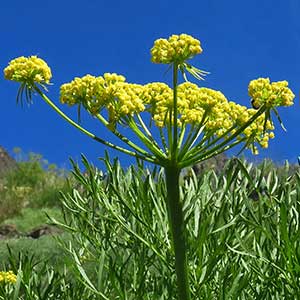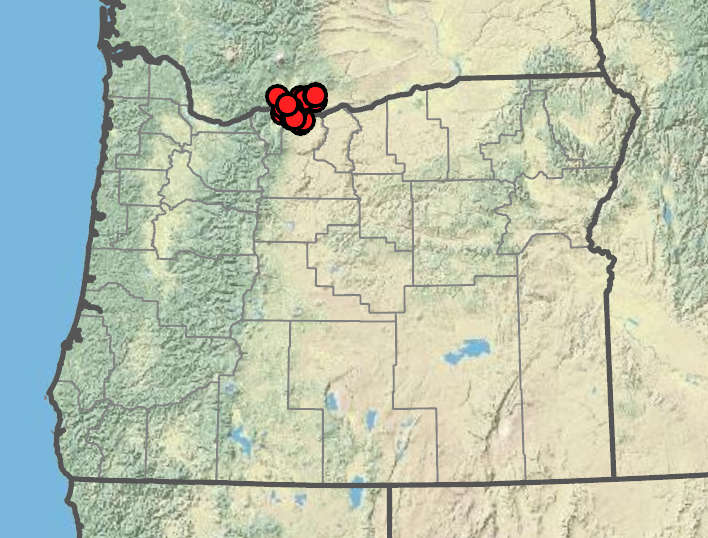Lomatium suksdorfii
Lomatium cookii
Suksdorf's desert parsley, Suksdorf's lomatium
agate desert parsley, Cook's lomatium
stout and thickened, elongate taproots or stout and irregularly thickened taproots.
slender or irregularly thickened elongate taproots.
2–3-branched or multicipital;
basal leaf sheaths from previous years weathering into a fibrous thatch at or below ground level;
peduncles persistent in thatch as gray stalks.
simple or 2–8-branched;
basal leaf sheaths from previous years absent or weathering into a sparse thatch of a few; loose fibers or chaffy scales at base of pseudoscape.
9–20 dm; stout but not inflated; pseudoscapes absent.
absent; pseudoscapes 1–4 cm, subterranean, obscured by leaf sheaths.
glabrous;
primary leaflets pinnate, 3–7 secondary leaflet pairs along each rachis (mature basal leaves may have more pairs; but these are not usually collected for specimens);
laterals less than half of central primary in length;
secondaries pinnate or pinnatifid;
tertiaries entire or pinnatifid (2–4-lobed), ultimate apical lobes linear, narrowly oblong, narrowly elliptic, 10–30 × 1–3 mm;
tips acute, acuminate, or subacute, mucronulate or not.
glabrous;
primary leaflets pinnate, 4–6 secondary leaflet pairs along each rachis;
laterals subequal to central primary in length;
secondaries pinnate;
tertiaries entire or pinnatifid (2–4-lobed), ultimate apical lobes linear or narrowly oblong, 2–5 × 0.3–0.7 mm;
tips acute, subacute, acuminate, mucronulate or not.
1–3, similar to basal.
0.
peduncles 1–4 (more in robust plants), ascending or erect; stout but not inflated, 30–80+ cm;
involucral bracts 0;
rays 8–20, 3–11 cm, glabrous;
involucel bractlets 4–6, linear or lanceolate, 5–10 × 0.3–1 mm, unlobed or 2-lobed;
margins narrowly scarious or not;
umbellets 10–40-flowered;
pedicels 6–17 mm.
peduncles 1–4, 15–40 cm, glabrous below, glabrate or sparsely scaberulose or muriculate above;
involucral bracts 0;
rays 1–12, 2–10 cm, glabrous, glabrate, or sparsely scaberulose or muriculate on ridges;
involucel bractlets 4–6, linear or oblanceolate, 3–10 × 0.5–1 mm;
margins scarious;
umbellets 10–20-flowered;
pedicels 1–5 mm.
petals yellow;
anthers ochroleucous or yellow.
petals ochroleucous or yellow;
anthers ochroleucous or yellow.
oblong, 15–25 mm, glabrous;
body 4–6 mm wide;
wings 1–3 mm; thin;
vittae 1–4 in intervals, 2 on commissure.
oblong to elliptic, 8–14 mm, glabrous;
body 2–3 mm wide;
wings 1–2 mm; corky-thickened;
vittae obscure.
Lomatium suksdorfii
Lomatium cookii
Gravelly or rocky slopes, talus, rock outcrops, scrubland, oak forests, conifer forests. Flowering Apr–Jun. 50–100 m. Col, ECas. WA. Native.
Vernal pools, seasonally-wet meadows. Flowering Apr–May. 300–500 m. Sisk. Native. Endemic to Oregon.
See discussion for Lomatium bradshawii.
Jason Alexander
Jason Alexander





